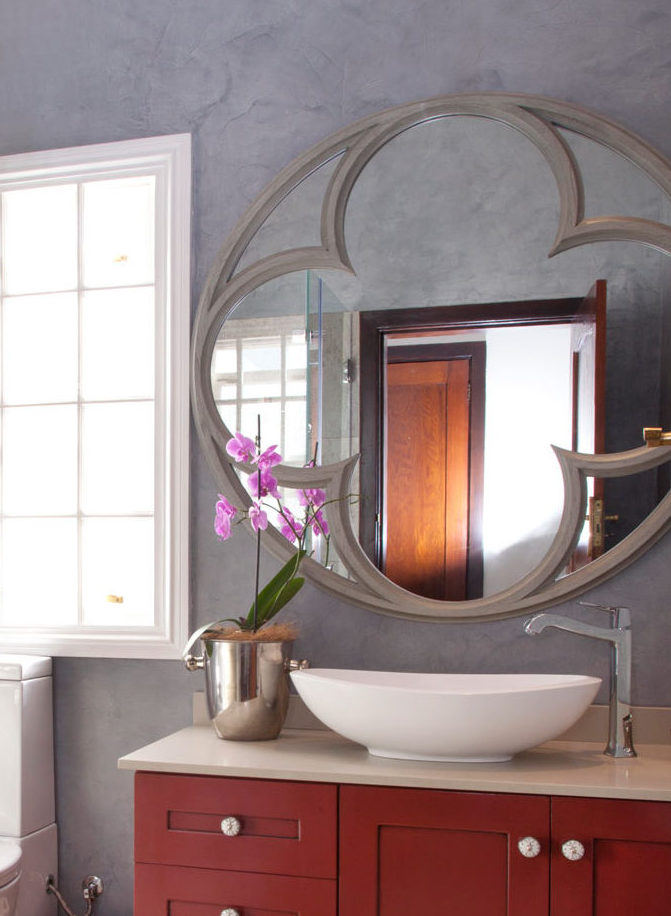The bathroom is one of the easiest places to go green. Whether you’re renovating or just redecorating, here are some great bathroom ideas to make yours more eco-friendly.

GREEN CHANGES YOU CAN MAKE IF YOU’RE BUILDING OR RENOVATING
- Choose smart fittings
Durban bathroom designer Sally Shaw, who believes strongly in eco-friendly updates and renovated this bathroom (pictured left), advises looking for bathroom fittings that are designed to reduce water consumption. “Hansgrohe’s Eco-Smart technology makes going eco-friendly a breeze,” says Sinovuyo Dumalisile of Hansgrohe Africa. “Our taps, mixers and showerheads use 60 percent less water than conventional products thanks to a sophisticated flow limiter, special jets and the addition of air.” Another of Hansgrohe’s technologies, CoolStart, ensures that only cold water flows when the mixer is set to the middle position, so that pipes don’t fill up with hot water unnecessarily. Hot water is only added when you move the lever to the left, reducing energy consumption.
Sally also suggests donating or recycling your old fittings and fixtures as the owners of this bathroom did.
YOU’LL ALSO LOVE: How to survive load shedding
- Upcycle it yourself
“We really stuck to our eco-friendly guns in this bathroom. Instead of replacing this old vanity, we simply updated it with a paint technique by Paint Illusions and new door handles to give it a fresh look,” says Sally.
- Replace the toilets
“Old toilets use about 13 litres of water per flush,” says Sally. “The new dual-flush toilets use about seven litres, and are well worth investing in,” says Debbie Schmidt of On Tap.
- Use low VOC paint
Give your bathroom a new look and some green credentials with a coat of eco-friendly paint. Here, Sally used chemical-free Earthcote Pandomo from Paint and Place on the walls.
- Bin the bath
Sally says that the first thing you should consider is getting rid of the bath. “The average bath uses 60 litres of hot water while eco-friendly showerheads use approximately 15 litres per shower, reducing the consumption of both water and electricity.”
READ MORE: Live a zero waste lifestyle at home
ALTERNATIVE ENERGY SOURCES FOR HEATING WATER
Solar-powered geysers and heat pumps are some of the best ways to reduce your impact on the environment. “By installing a solar-powered geyser you can have free hot water, even during load shedding,” says Debbie Schmidt, Merchandise Manager of On Tap. “Eskom offers rebates on the purchase and installation of both solar-powered geysers and heat pumps.”
READ MORE: An eco-friendly seaside home
Conventional geysers use three units of electrical energy to produce three units of heat energy, whereas a heat pump only uses one unit of electrical energy to produce three units of heat energy. “Replacing two 150 litre geysers with a solar geyser system costs about the same as adding two 4kW output heat pumps to each existing geyser and either option will save you money in the long run,” says Debbie.
GREEN CHANGES YOU CAN MAKE TODAY
Cover up
Fit a geyser blanket to your existing geyser. “In a typical household, 40 percent of the electricity consumption is due to water heating, so it’s important to reduce heat loss in this area,” says Debbie Schmidt of On Tap. “As the temperature of water in a geyser drops around one degree per hour, constant energy is required to maintain the heat. A blanket can halve the amount of energy needed.”
Be energy conscious
Replace your globes with energy-saving LEDs or low-voltage downlights and switch your geyser off during the day. If you’re buying a heated towel rail, consider the Jeeves Hydronic Classic C, from On Tap, which is heated by circulating hot water through the tubes so it doesn’t need an additional electrical heating element.
Be water wise
Fit a water-saving flushing system to your existing toilet to reduce the amount of water in each flush.
Look for sustainable materials
Quick-growing bamboo is an exceptionally sustainable, versatile product. Buying bamboo bath mats, towels and other accessories is an easy way to up your green cred in the bathroom.
Shower power
“You don’t have to wait for a renovation to change your showerhead to an eco-friendly one,” says designer Sally Shaw. “All the arm fittings are universal so you can do it yourself without the need for a plumber.”
Select natural products
Choose eco-friendly cleaning and bath products which are free from synthetic chemical ingredients which may be harmful to the environment.

